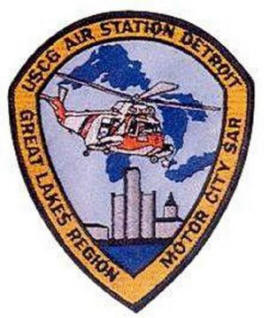Air Station Detroit History

Air Station Detroit is located at Selfridge Air National Guard Base in Mount Clemens, MI, nestled in a quiet suburb 20 miles north of Detroit. Commissioned in June of 1966, air station personnel first occupied an excess Air Force hangar until construction of the current facility could be completed in July of 1967. Two years later, the hangar was dedicated in memory of LT Jack C. Rittichier, the only Coast Guard aviator to be killed in the Vietnam conflict. LT Rittichier, an air station plankowner, was an exchange pilot with the Air Force 37th ARRS when, while attempting to rescue a fellow aviator, he was shot down and killed in action on June 9, 1968.
An integral part of the Coast Guard's National Search and Rescue (SAR) effort, the air station came under the operational control of the Ninth Coast Guard District in Cleveland, OH. During the 1970s, the air station was manned by 14 officers and 32 enlisted crewmen, who flew three HH-52A turbine powered amphibious helicopters, and maintained a 24 hour SAR alert readiness posture. The unit's primary area of responsibility was the maritime environment of the eastern Great Lakes region. This area has over 1,000 miles of shoreline and encompasses Lake Ontario, Lake Erie, Lake St. Clair, and Lake Huron south of the 44th parallel.
In addition to SAR operations, Air Station Detroit supported the 32 Coast Guard units and five major vessels in the eastern Great Lakes region. This support consisted of ice reconnaissance flights for the winter navigation season, law enforcement and safety patrols, environmental protection flights, and logistical support for all Coast Guard units in the area. The air station also cooperated closely with the U.S. and Canadian government agencies on the federal, state or provincial, and local levels.
The air station held a Meritorious Unit Commendation for service from July 1, 1977 through March 31, 1978 while engaged in operations involving major search and rescue cases, law enforcement, aids to navigation, assistance to various federal agencies, ice reconnaissance, shipboard deployments, and maritime environmental protection. More recently, however, the air station has distinguished itself through major contributions of aircraft and flight crewmembers in support of Cuban refugee operations and the Haitian interdiction program.
As of 2005, the command had an active duty complement of 24 officers, 80 enlisted personnel, and four civilians employing five Airbus MH-65 Dolphin helicopters to maintain a 24 hour SAR and law enforcement aircraft on alert for an area extending along 1,100 miles of shoreline from Saginaw Bay, MI to the St. Lawrence Seaway. The air station conducts over 230 SAR missions annually that saved an average of more than 30 lives and provided assistance to over 200 others.